
Embarking on an indoor gardening journey brings the beauty of nature into the heart of your home while offering a rewarding and therapeutic experience. Whether you're a seasoned green thumb or a novice plant enthusiast, mastering the essentials of indoor gardening ensures success and a thriving indoor oasis.
Lighting: Adequate light is crucial for indoor plants. Identify the light requirements of your plants and position them accordingly. South-facing windows usually provide the brightest light, but supplemental artificial lighting, such as fluorescent or LED grow lights, can be beneficial, especially in low-light conditions.
Choosing the Right Plants: Select plants that thrive indoors. Common choices include snake plants, pothos, spider plants, and peace lilies for low-light areas, while herbs, succulents, and flowering plants like orchids may prefer brighter conditions.
Container and Soil: Use well-draining containers with drainage holes to prevent overwatering. Opt for high-quality potting soil specifically formulated for indoor plants, ensuring proper aeration and nutrient content. Get in touch with Eco Green Plants for indoor plant rental in Melbourne today.
Watering: Strike the right balance with watering. Overwatering can lead to root rot, while underwatering can cause stress. Allow the top inch of soil to dry before watering and adjust the frequency based on the plant's specific needs.
Humidity Control: Many indoor plants thrive in a humid environment. Grouping plants together, using a humidity tray, or placing a humidifier in the room can create the optimal moisture levels for your indoor garden.
Temperature: Most indoor plants prefer temperatures between 60-75°F (15-24°C) during the day and slightly cooler at night. Avoid placing plants near drafts, heaters, or air conditioning vents.
Fertilizing: Indoor plants benefit from regular feeding during the growing season. Choose a balanced, water-soluble fertilizer and follow the recommended application rates on the packaging.
Pruning and Maintenance: Regularly check your plants for signs of pests, diseases, or overgrowth. Prune as needed to encourage healthy growth and remove any dead or yellowing leaves.
Indoor gardening is a delightful way to bring nature into your living space. By understanding and implementing these fundamental principles, you can cultivate a flourishing indoor garden that not only enhances your home decor but also contributes to a healthier and happier living environment.
